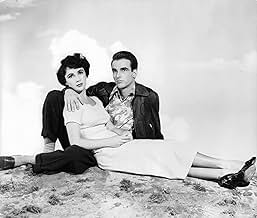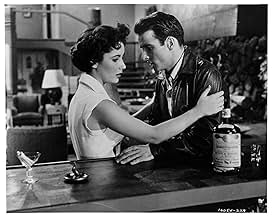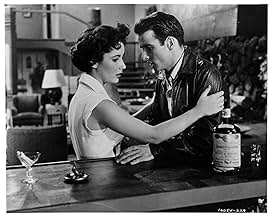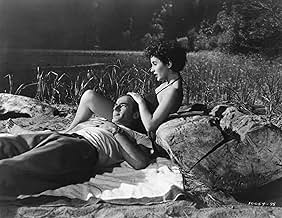IMDb रेटिंग
7.7/10
26 हज़ार
आपकी रेटिंग
एक गरीब लड़का अपने अमीर चाचा के लिए नौकरी करता है और अंततः उसे दो महिलाओं से प्यार हो जाता है.एक गरीब लड़का अपने अमीर चाचा के लिए नौकरी करता है और अंततः उसे दो महिलाओं से प्यार हो जाता है.एक गरीब लड़का अपने अमीर चाचा के लिए नौकरी करता है और अंततः उसे दो महिलाओं से प्यार हो जाता है.
- 6 ऑस्कर जीते
- 18 जीत और कुल 12 नामांकन
Robert J. Anderson
- Eagle Scout
- (बिना क्रेडिट के)
Gertrude Astor
- Bit Part
- (बिना क्रेडिट के)
फ़ीचर्ड समीक्षाएं
A Place in the Sun (1951)
**** (out of 4)
Oscar-winning tale of a poor boy (Montgomery Clift) who goes to work for his uncle hoping to one day be rich like him. He falls in love with a small time woman (Shelley Winters) but soon gets a taste of the society life with a beauty (Elizabeth Taylor) and this is the start of his downfall. A PLACE IN THE SUN went home with six Oscars including Best Director for George Stevens and it's easy to see why he took home the award because there's so much going on in this picture yet he holds it together perfectly. The film is part melodrama, part message film, part romance and part suspense and Stevens really brings all of it together so perfectly that you can't help but get drawn into the story and feel every bit of pain that the characters do. The most amazing thing for me, and I'm not sure if it was meant to happen this way, but I really felt a lot of sympathy for the Clift character. Again, I'm not sure if this was the filmmakers intent but no matter how much I disagreed with what he was doing at the same time I never once hated him and even to the end I was hoping things would turn his way. I think some of this credit should be given to Clift who once again turns in a remarkable performance. I thought the shyness early on, the romance with Taylor and the hatred that someone is going to take away his dreams are all things that Clift perfectly nailed. The sequence on the boat towards the end is something masterfully performed by the actor. Taylor is also extremely good in her part even though of all the main characters I think hers is the most underwritten. Winters is also very good in her role of the woman who finds herself being left behind for someone better. I thought all the scenes between her and Clift, be it romantic or fighting, were full of wonderful chemistry. Anne Revere is a standout as Clift's mother and Raymond Burr is good in his few scenes. Again, a lot of credit has to go to Stevens because every aspect of the film works. The early love story between Clift and Shelley works. The love story between Clift and Taylor works. The downright suspense on the boat at night works. Even the ending manages to work. A PLACE IN THE SUN deserves its place as an all-time classic.
**** (out of 4)
Oscar-winning tale of a poor boy (Montgomery Clift) who goes to work for his uncle hoping to one day be rich like him. He falls in love with a small time woman (Shelley Winters) but soon gets a taste of the society life with a beauty (Elizabeth Taylor) and this is the start of his downfall. A PLACE IN THE SUN went home with six Oscars including Best Director for George Stevens and it's easy to see why he took home the award because there's so much going on in this picture yet he holds it together perfectly. The film is part melodrama, part message film, part romance and part suspense and Stevens really brings all of it together so perfectly that you can't help but get drawn into the story and feel every bit of pain that the characters do. The most amazing thing for me, and I'm not sure if it was meant to happen this way, but I really felt a lot of sympathy for the Clift character. Again, I'm not sure if this was the filmmakers intent but no matter how much I disagreed with what he was doing at the same time I never once hated him and even to the end I was hoping things would turn his way. I think some of this credit should be given to Clift who once again turns in a remarkable performance. I thought the shyness early on, the romance with Taylor and the hatred that someone is going to take away his dreams are all things that Clift perfectly nailed. The sequence on the boat towards the end is something masterfully performed by the actor. Taylor is also extremely good in her part even though of all the main characters I think hers is the most underwritten. Winters is also very good in her role of the woman who finds herself being left behind for someone better. I thought all the scenes between her and Clift, be it romantic or fighting, were full of wonderful chemistry. Anne Revere is a standout as Clift's mother and Raymond Burr is good in his few scenes. Again, a lot of credit has to go to Stevens because every aspect of the film works. The early love story between Clift and Shelley works. The love story between Clift and Taylor works. The downright suspense on the boat at night works. Even the ending manages to work. A PLACE IN THE SUN deserves its place as an all-time classic.
This 1950s melodrama was an interesting, involving story. It's part film-noir, too, which I liked. I say that because the last third of the film featured an expectation of some dreaded act about to be committed, giving it a film noir feel.
One thing for sure, whatever you label the movie: it's well-acted, well-directed and well-photographed. Regarding the latter, this really looks good on DVD. No surprise it's directed well since George Stevens was the director. His resume speaks for itself.
Obviously Montgomery Clift and Elizabeth Taylor are the "big names" in this film, but I found Shelly Winters and the character she played to be the most intriguing. She wasn't really appealing yet one could certainly identify with her feelings of insecurity with Taylor as her competition. "Liz" was in in her prime, looks-wise, with an absolutely classic face.
Anyway, watching the character studies of the antsy Winters and the troublesome Clift were interesting. Clift, as is the case with most of us, causes his own problems and things slowly unravel for him. The story is another example of what can happen when one tries to cover up the truth. It comes back to bite you, big-time!
I really found it refreshing, however, to see Clift's attitude at the end. It's the exact opposite of what you hear today. He actually takes responsibility for his actions.
One thing for sure, whatever you label the movie: it's well-acted, well-directed and well-photographed. Regarding the latter, this really looks good on DVD. No surprise it's directed well since George Stevens was the director. His resume speaks for itself.
Obviously Montgomery Clift and Elizabeth Taylor are the "big names" in this film, but I found Shelly Winters and the character she played to be the most intriguing. She wasn't really appealing yet one could certainly identify with her feelings of insecurity with Taylor as her competition. "Liz" was in in her prime, looks-wise, with an absolutely classic face.
Anyway, watching the character studies of the antsy Winters and the troublesome Clift were interesting. Clift, as is the case with most of us, causes his own problems and things slowly unravel for him. The story is another example of what can happen when one tries to cover up the truth. It comes back to bite you, big-time!
I really found it refreshing, however, to see Clift's attitude at the end. It's the exact opposite of what you hear today. He actually takes responsibility for his actions.
This film is very different from anything of it's time that I have ever seen.A man has a one night stand with a coworker and gets her pregnant.THEN he meets the woman of his dreams,the woman with everything;charm,good looks and Daddy's money.We then have a man who is torn between choosing to have it all and doing the right thing.The result of his struggles ends up very tragically as you will see.I was very taken aback by the film's sexual overtones,though it was only hinted at,of course.With the barrage of remakes in recent years,I am surprised it has not been remade with stronger sexual content.This is a very enjoyable film with good performances all around,particularly those of Shelley Winters and Monty Clift.Liz Taylor's strong screen presence is also a delight.A definite thumbs up.
Time does extraordinary things with greatness. If nothing else it confirms it. "A Place in the Sun" is a remarkable example of that theory. I rushed to buy a DVD after watching a BBC documentary on ELizabeth Taylor to celebrate her 75th birthday! In "A Place on the Sun" an Elizabeth Taylor barely out of her teens is paired with Montgomery Clift. She had been raised at MGM and groomed for movie stardom from day one. He was a method actor, complex, introspective and their coupling produced something that I'm tempted to call, unrepeatable. The actors own personal stories, their friendship, mutual love and respect made it possible for their communion to be so transcendental. To make things even more perfect, the film seems a love letter from director George Stevens to his stars and vice versa. Look at the opening credits and tell me if you've ever seen a more startling introduction to a character/star. The story of doomed love and descend into darkness is, without question, one of the best ever made.
10bmacv
Bringing Theodore Dreiser's sprawling novel An American Tragedy to the screen must have been a daunting task, made harder by the constraints Paramount imposed on director George Stevens. The studio had lost big on a version made 20 years earlier, under Josef von Sternberg, and had little faith in a remake. So, hobbled by a tight budget, Stevens scaled back his ambitious plans but delivered, perhaps even to his own surprise, a superbly crafted and and powerfully sustained work of movie art.
He was lucky that Paramount, edgy about the story, gave him a cast that would guarantee not only good box office but solid performances as well. Montgomery Clift, Elizabeth Taylor and Shelly Winters take the principal roles, with, in the last third of the movie, extra oomph courtesy of Raymond Burr (in a role that may have nabbed him the Perry Mason franchise).
The jaws of the vise Clift finds himself squeezed into are class and sex. Barely educated, raised by stern members of a religious sect, he luckily (or not) happens to be the shirt-tail nephew of a prosperous entrepreneur who casually offers him work in his factory. Awkward and lonesome, Clift escapes the drudgery of his job by taking up with a mousy co-worker (Winters, toned way down from her platinum-bombshell image at the time). But his nose-to-the-grindstone ways attract the attention of his uncle, who rewards him with a promotion and an invitation up to the manor.
There he meets Taylor and launches an obsession about her, reinforced by a neon sign visible from his window that blazes her surname through his restless nights (she's another child of an industrial fortune, raised in wealth and privilege). Somehow, she falls for him and, need it be added, he for her despite his coming from the wrong side of the tracks (she hasn't the faintest notion that for people like him, life may not be the blithe affair it is for her).
Only one inconvenient fact keeps Clift from taking his rightful place in the sun: He's left Winters pregnant. The two worlds he occupies are destined to collide, and crash they do when Winters phones him, in the midst of a Hawaiian-themed luau at Taylor's summer place on the lake, to issue her ultimatum: Marry her or she'll spill their sordid secret. He leaves abruptly to meet Winters, desperately trying to assemble the plan which will seal three fates.
Stevens sustains an overwhelming, ominous momentum, unbroken by even a hint of levity (not even a single bit player is allowed to lapse into shtik). Languorous dissolves and superimposed images heighten the sense of inevitability as each scene, each event glides seamlessly into the next.
Maybe he wasn't able to pile on the exhaustive social commentary that bulked up Dreiser's novel, but everywhere there's sharp detail that he adroitly leaves to be noticed. When Clift shows up hours late at his intimate birthday party in Winter's cramped room, with the tiny table pushed up against her marble washstand, the ice cream has warmed to lumpy syrup (a self-homage to a similar scene in Steven's Alice Adams?). With an island combo playing merrily on, Clift sports a lei and eats pineapple out of its shell when Winters calls to break the spell and this South-Seas reverie is offered up not as Veblenesque excess, but merely as the way Taylor's crowd spend their days and evenings and nights in an endless round of heedless gaiety.
The apex of the film's crescendo is handled with tight, quiet assurance the reckoning in a rowboat upon a deserted lake. Dusk gathers among the pines like fog, the loons call back and forth, and the rippling waves reflect a demented flash into Clift's eye as he wrestles with his conscience. Winters natters nervously about the dreary life they'll spend together while his head swims with luminous visions of Taylor. Then, destiny catches.... Romantic but unsentimental, serious but without pretension, gripping without stooping to the manipulative, A Place in the Sun ranks as a masterpiece of American cinema.
He was lucky that Paramount, edgy about the story, gave him a cast that would guarantee not only good box office but solid performances as well. Montgomery Clift, Elizabeth Taylor and Shelly Winters take the principal roles, with, in the last third of the movie, extra oomph courtesy of Raymond Burr (in a role that may have nabbed him the Perry Mason franchise).
The jaws of the vise Clift finds himself squeezed into are class and sex. Barely educated, raised by stern members of a religious sect, he luckily (or not) happens to be the shirt-tail nephew of a prosperous entrepreneur who casually offers him work in his factory. Awkward and lonesome, Clift escapes the drudgery of his job by taking up with a mousy co-worker (Winters, toned way down from her platinum-bombshell image at the time). But his nose-to-the-grindstone ways attract the attention of his uncle, who rewards him with a promotion and an invitation up to the manor.
There he meets Taylor and launches an obsession about her, reinforced by a neon sign visible from his window that blazes her surname through his restless nights (she's another child of an industrial fortune, raised in wealth and privilege). Somehow, she falls for him and, need it be added, he for her despite his coming from the wrong side of the tracks (she hasn't the faintest notion that for people like him, life may not be the blithe affair it is for her).
Only one inconvenient fact keeps Clift from taking his rightful place in the sun: He's left Winters pregnant. The two worlds he occupies are destined to collide, and crash they do when Winters phones him, in the midst of a Hawaiian-themed luau at Taylor's summer place on the lake, to issue her ultimatum: Marry her or she'll spill their sordid secret. He leaves abruptly to meet Winters, desperately trying to assemble the plan which will seal three fates.
Stevens sustains an overwhelming, ominous momentum, unbroken by even a hint of levity (not even a single bit player is allowed to lapse into shtik). Languorous dissolves and superimposed images heighten the sense of inevitability as each scene, each event glides seamlessly into the next.
Maybe he wasn't able to pile on the exhaustive social commentary that bulked up Dreiser's novel, but everywhere there's sharp detail that he adroitly leaves to be noticed. When Clift shows up hours late at his intimate birthday party in Winter's cramped room, with the tiny table pushed up against her marble washstand, the ice cream has warmed to lumpy syrup (a self-homage to a similar scene in Steven's Alice Adams?). With an island combo playing merrily on, Clift sports a lei and eats pineapple out of its shell when Winters calls to break the spell and this South-Seas reverie is offered up not as Veblenesque excess, but merely as the way Taylor's crowd spend their days and evenings and nights in an endless round of heedless gaiety.
The apex of the film's crescendo is handled with tight, quiet assurance the reckoning in a rowboat upon a deserted lake. Dusk gathers among the pines like fog, the loons call back and forth, and the rippling waves reflect a demented flash into Clift's eye as he wrestles with his conscience. Winters natters nervously about the dreary life they'll spend together while his head swims with luminous visions of Taylor. Then, destiny catches.... Romantic but unsentimental, serious but without pretension, gripping without stooping to the manipulative, A Place in the Sun ranks as a masterpiece of American cinema.
क्या आपको पता है
- ट्रिवियाIn her autobiography, Shelley Winters described producer and director George Stevens' way of working: "He would discuss the scene, but not the lines, and would photograph the second or third rehearsal so the scene had an almost improvisatory quality. Stevens would print the first take, then spend the next three hours minutely rehearsing the scene, then film it again. He explained to me that in this way he often got actors' unplanned reactions that were spontaneous and human and often exactly right. And often when actors overintellectualize or plan their reactions, they aren't as good."
- गूफ़Alice Tripp is wearing different shoes when she starts walking home from the movie with George Eastman from those she is wearing when they near her residence. When Shelley Winters pointed out to director George Stevens that the brown and white shoes she was wearing turned to black when she walked around the corner, the director refused to re-shoot the scene. According to Winters, he said, "If they're looking at her feet, I can go home."
- कनेक्शनFeatured in Hollywood: The Fabulous Era (1962)
टॉप पसंद
रेटिंग देने के लिए साइन-इन करें और वैयक्तिकृत सुझावों के लिए वॉचलिस्ट करें
विवरण
बॉक्स ऑफ़िस
- बजट
- $22,95,304(अनुमानित)
- दुनिया भर में सकल
- $18,247
- चलने की अवधि2 घंटे 2 मिनट
- रंग
- पक्ष अनुपात
- 1.37 : 1
इस पेज में योगदान दें
किसी बदलाव का सुझाव दें या अनुपलब्ध कॉन्टेंट जोड़ें







































